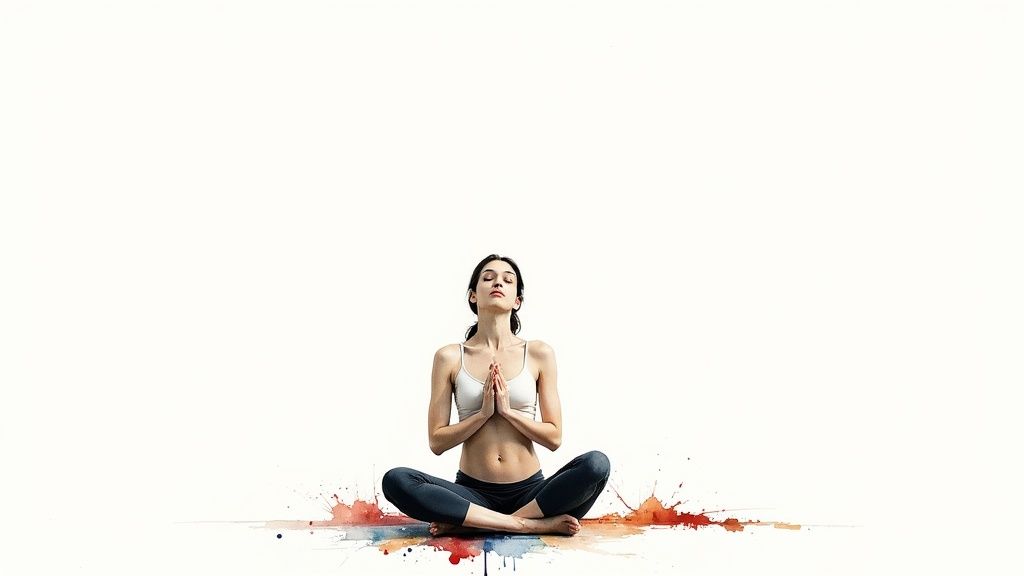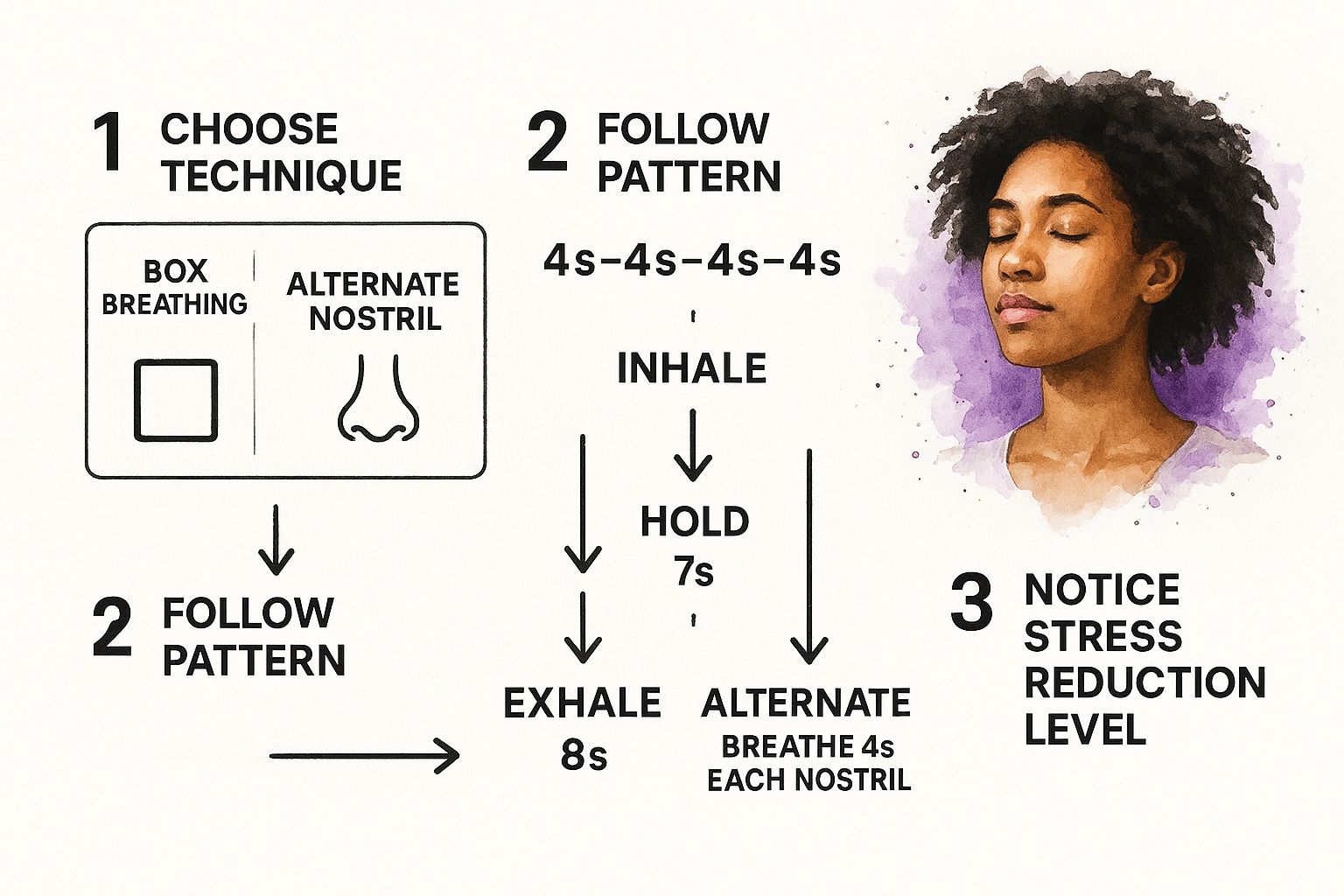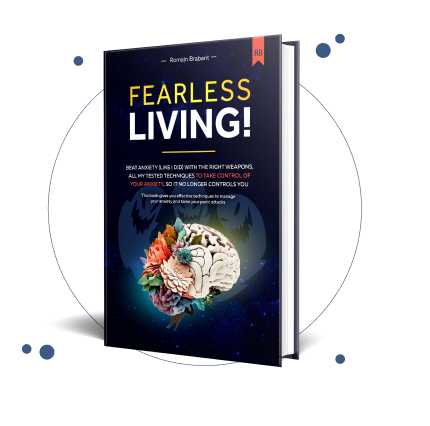
When stress hits, your breath is one of the most powerful tools you have to instantly calm your nervous system. By deliberately slowing down your breathing, you send a powerful message straight to your brain, dialing down the physical symptoms of stress and offering real relief when you feel overwhelmed.
Your Path to a Calmer, Panic-Free Life

Feeling trapped by anxiety can be an exhausting, all-consuming battle. It's easy to start believing that the cycle of stress, worry, and even panic is just how life is. But I want to assure you, there's a real, accessible path toward a life where you feel in control. This guide is your first step on that path.
The journey starts with something you already do roughly 20,000 times a day: breathing. We're going to explore the profound connection between your breath and your nervous system, turning something as simple as an intentional breath into a powerful anchor during life's most challenging moments.
This isn't about ignoring or pushing down your feelings. It's about developing mastery over your body's physical responses with a tool you've had all along. It’s about learning to navigate challenges with a newfound sense of confidence.
This approach isn't just wishful thinking; it's rooted in the way our bodies are designed. By learning specific breathing exercises for stress relief, you can directly influence your body’s "fight or flight" response, gently guiding it back to a state of calm.
Building Hope One Breath at a Time
Imagine starting your day not with a wave of dread, but with a few quiet, intentional breaths that set a peaceful tone. Picture yourself in a stressful work meeting or a tough conversation, discreetly using a breathing technique to stay centered and think clearly. This kind of self-regulation isn't reserved for monks or wellness gurus; it's completely achievable for you.
This path toward a panic-free life is built on small, consistent actions. Here’s what that really looks like:
- Starting Small: You don’t need to carve out hours for meditation. Just a few minutes each day can start to rewire your nervous system for calm.
- Finding Your Anchor: Your breath becomes a reliable anchor you can turn to anytime, anywhere. It transforms moments of rising panic into moments of personal power.
- Building Resilience: With every practice, you're strengthening the neural pathways that promote calm, slowly making it your body's new default setting.
Beyond Breathing: Foundational Self-Care
A truly calm and panic-free life, however, goes beyond just mental techniques. It rests on a foundation of solid self-care, and restorative sleep is a critical piece of that puzzle. Quality rest is essential for regulating stress hormones and giving your mind and body the chance to repair.
Taking steps to improve your sleep environment is a powerful act of self-care. It's amazing how much of a difference the right bedding can make; you can learn more about how to get more restful nights and discover comfortable sleep with bamboo cooling sheets.
Ultimately, the most important thing to remember is that you are not broken, and healing is absolutely possible. This guide will give you the tools, but your commitment to taking that first conscious breath is what truly opens the door to a calmer, more present, and panic-free life. Your journey starts now.
Ever wonder why taking a slow, deep breath in the middle of a panic feels so unbelievably calming? It’s not your imagination or some kind of placebo effect. It’s pure biology, and understanding how it works is empowering.
This knowledge transforms breathing from a hopeful suggestion into a powerful, physiological tool. You can use it to actively manage your body's stress response.
The Vagus Nerve: Your Body’s Built-In Reset Button
Think of your breath as a remote control for your nervous system. When you feel anxious, stressed, or on the verge of panic, your body flips into sympathetic nervous system mode—you probably know it as "fight or flight."
This is an ancient survival instinct. It floods your body with adrenaline and cortisol, sending your heart rate through the roof and making your breathing shallow and fast. It's designed to help you escape a real predator, but in our modern world, it's often triggered by work deadlines, awkward social events, or a storm of overwhelming thoughts.
The key to switching off this internal alarm is to activate its counterpart: the parasympathetic nervous system, or the "rest and digest" state. And the main channel to do that is the vagus nerve. This long, wandering nerve is a superhighway connecting your brain to your major organs, including your heart and lungs.
When you intentionally slow down your breathing—especially your exhale—you stimulate the vagus nerve. This sends a clear, direct message to your brain: "The danger has passed. It's safe to calm down."
In response, your brain tells your body to dial back the stress hormones, which in turn lowers your heart rate and blood pressure. You are, quite literally, manually overriding your body's panic button.
This isn't just a neat theory; it’s a well-documented scientific reality. A 2023 meta-analysis looked at 58 different studies and found that in 54 out of 72 breathing interventions, there were statistically significant drops in stress and anxiety. The most effective methods? Simple slow breathing and deep diaphragmatic breathing. You can dive into the full study on the global efficacy of breath regulation on PMC if you're curious.
Turning Knowledge into Actionable Hope
Understanding this science is the first step toward truly believing you can heal from anxiety and live without panic. It proves you have real agency over your physical state, even when your thoughts feel like they’re running the show.
Your breath is always with you. That makes it the most reliable and immediate tool you have for relief.
Every intentional, slow breath you take is a conscious choice to move out of anxiety and into a state of calm. It's a reminder that you are not at the mercy of your body's stress reactions; you are an active participant in your own well-being.
This biological link is exactly why breathing exercises for stress relief are a cornerstone for managing a whole spectrum of anxiety-related challenges. While the experience of anxiety is complex and deeply personal, getting a handle on the physiological side of things can be a game-changer on the road to recovery.
For those looking to better understand the different ways anxiety can show up, our guide on various anxiety disorders offers some valuable context.
You don't need a degree in anatomy to make this work for you. Just remember this simple truth: a slow, controlled breath tells your brain it's time to relax. This simple action, when practiced consistently, can create profound changes, offering a real, tangible path away from the grip of chronic stress and toward a more peaceful, centered life.
Four Powerful Breathing Techniques to Use Today
Now that you know how deeply your breath is connected to your body’s stress response, it’s time to put that knowledge to work. This is where the idea of a panic-free life starts to feel less like a dream and more like a real, achievable goal. We're moving from theory to practice, stocking your personal toolkit with powerful techniques you can use the moment you finish reading this.
Don't worry, these aren't complicated rituals. They are simple, accessible skills you can practice anywhere—at your desk before a meeting, in your car stuck in traffic, or while waiting in line at the grocery store. Think of them as your immediate allies in managing anxiety.
Diaphragmatic Breathing for Deep Relaxation
Most of us, especially when we’re stressed, take shallow breaths from our chests. This signals tension to the nervous system. Diaphragmatic breathing, often called belly breathing, is the complete opposite. It’s the natural, deep way babies breathe, and it's the most efficient way to send a "safe" signal to your brain.
To give it a try, place one hand on your chest and the other on your stomach, right below your rib cage. Take a slow, gentle breath in through your nose. The real goal here is to feel the hand on your stomach rise noticeably while the hand on your chest stays relatively still.
As you exhale, let it out slowly through your mouth, feeling the hand on your stomach lower. This simple physical feedback helps your body re-learn how to engage the diaphragm, the large muscle that was designed for breathing. Studies show this type of breathing directly engages the vagus nerve, helping to lower your heart rate and blood pressure. It’s a biological message that tells your body you are safe.
This isn't just an exercise; it's about re-learning your body's natural state of calm. Each deep belly breath is a quiet act of self-reassurance, a powerful step toward healing your body's conditioned response to stress.
Try to practice this for five minutes a day. If you feel a little lightheaded at first, that’s perfectly normal, especially if you’re not used to it. Starting out by lying down can make it easier, and before you know it, it will feel like second nature.
Box Breathing to Find Focus in Chaos
Picture this: you have a critical presentation in ten minutes, and your heart is pounding. This is the perfect moment for Box Breathing. It's a technique used by Navy SEALs, police officers, and nurses for its incredible ability to restore focus and calm under pressure.
Its power lies in its simple, predictable rhythm. You’re essentially creating a "box" with your breath using four equal counts:
- Inhale slowly through your nose for a count of four. Feel the air fill your lungs.
- Hold your breath for a count of four. Try to relax, not clench your muscles.
- Exhale slowly through your mouth for a count of four. Release the air completely.
- Hold your breath out for another count of four.
Repeat this cycle four or five times. The structured rhythm is incredibly grounding. It gives your racing mind something steady to focus on, breaking the chaotic loop of anxious thoughts. By imposing order on your breath, you impose order on your nervous system. It's your secret weapon for keeping your cool when the pressure is on.
The infographic below gives you a simple visual guide to help you pick a technique and follow its pattern, making it even easier to get started.

As you can see, you can quickly select and use a breathing pattern to directly influence your stress levels in real-time.
The 4-7-8 Technique to Quiet a Racing Mind
Sleep is often the first thing to go when anxiety takes hold. If you’ve ever found yourself lying in bed with a mind that just won't shut down, the 4-7-8 technique can feel like a gift. Developed by Dr. Andrew Weil, it’s designed to act as a natural tranquilizer for the nervous system.
The magic is in the extended exhale, which is the most powerful part of the breath cycle for activating your parasympathetic "rest and digest" response. Here's the pattern:
- Exhale completely through your mouth, making a gentle "whoosh" sound.
- Close your mouth and inhale quietly through your nose for a count of four.
- Hold your breath for a count of seven.
- Exhale completely through your mouth with another "whoosh" sound for a count of eight.
When you're just starting, don't repeat this for more than four cycles. The prolonged hold allows more oxygen to saturate your bloodstream, while the extra-long exhale expels more carbon dioxide and dramatically slows your heart rate. It’s incredibly effective for dialing down the acute stress that keeps you staring at the ceiling.
Alternate Nostril Breathing to Restore Balance
Known in yoga as Nadi Shodhana, this practice is all about bringing balance and harmony to your mind and body. It's especially helpful on days when you feel scattered, emotionally turbulent, or just plain out of sorts.
Start by finding a comfortable seated position. Use your right thumb to gently close your right nostril.
- Inhale slowly and deeply through your open left nostril.
- At the top of your inhale, close your left nostril with your ring finger and release your thumb from the right nostril.
- Exhale slowly through your right nostril.
- Now, inhale through that same right nostril.
- Close the right nostril again with your thumb and exhale through the left.
That completes one full cycle. Continue this for several rounds, focusing on creating a smooth, even flow of breath. Research suggests this practice helps unify the two hemispheres of the brain, promoting an overall sense of calm and clarity. For a closer look at how different techniques can be used, our comprehensive guide on more breathing exercises for anxiety offers even more tools.
Breathing Techniques at a Glance
Feeling overwhelmed by the options? Don't be. Choosing the right technique is all about matching the tool to the moment. This quick table can help you decide which exercise to reach for based on how you're feeling right now.
| Technique | Best For | Core Pattern | When to Use |
|---|---|---|---|
| Diaphragmatic Breathing | Deep physical relaxation and daily stress reduction. | Inhale through the nose, letting the belly rise; exhale slowly through the mouth. | When you feel tense, or as a daily 5-minute practice to build resilience. |
| Box Breathing | Regaining focus and composure under pressure. | Inhale (4), Hold (4), Exhale (4), Hold (4). | Before a big meeting, during a stressful conversation, or anytime you need to think clearly. |
| 4-7-8 Breathing | Quieting a racing mind, especially before sleep. | Inhale (4), Hold (7), Exhale (8). | When you're lying in bed unable to sleep, or during moments of acute anxiety. |
| Alternate Nostril Breathing | Restoring emotional balance and mental clarity. | Inhale left, exhale right; inhale right, exhale left. | When you feel scattered, overwhelmed, or emotionally off-balance. |
Think of these techniques as different keys on a keychain. With a little practice, you’ll instinctively know which one to use to unlock a state of calm, no matter the situation.
Each of these methods is a concrete action you can take, proving that you have the power to influence how you feel. They aren’t just ways to cope; they are tools of empowerment that pave the way to a calmer, more confident, and panic-free life.
Making Calmness a Daily Habit

True, lasting change happens when breathing exercises for stress relief shift from an emergency rescue to a quiet, consistent part of your daily rhythm. This is the heart of healing—the gentle, everyday practice that builds a foundation of calm so strong that panic struggles to find a foothold. It’s about making wellness a habit, not a chore.
The incredible thing is that this doesn’t require a massive life overhaul. It starts with small, intentional moments woven into the life you already lead. This is where you begin to truly feel hope, seeing that a panic-free life isn’t some distant dream but a reality you can build, one breath at a time.
This path isn't about perfection. It’s about consistency and the profound belief that you have the power to steer your own nervous system toward peace.
Habit Stacking Your Way to Calm
One of the biggest hurdles people face is simply remembering to practice. We don't fail because we lack willpower; we fail because we lack a system. A simple yet powerful method to build this new habit is called habit stacking.
The idea is to link your new breathing practice to an existing, non-negotiable daily habit.
Instead of trying to find extra time in your day, you attach your five-minute breathing session to something you already do without thinking. This removes the friction of "when will I do this?" and makes it automatic.
- Morning Coffee: As your coffee brews, instead of scrolling through your phone, sit and practice diaphragmatic breathing. Link the aroma of coffee with the feeling of calm.
- Brushing Your Teeth: After you finish brushing your teeth in the evening, find a quiet spot and do a few rounds of the 4-7-8 technique to prepare for sleep.
- Starting Your Car: Before you put the car in drive, take three slow, intentional breaths. Use this moment to set a calm intention for your commute.
This approach makes your practice feel less like another item on your to-do list and more like a natural extension of your daily flow.
Practicing Calm in the Real World
The true test of these tools is how well they work outside the quiet of your home. The goal is to feel empowered everywhere, turning any moment into an opportunity for relief. You can practice discreetly without anyone even noticing.
- At Your Desk: Feeling overwhelmed by emails? Sit back in your chair, place your hands on your lap, and quietly practice Box Breathing. No one will know you’re actively calming your nervous system.
- Stuck in Traffic: Instead of letting frustration build, use the time for paced breathing. Focus on making your exhales slightly longer than your inhales. Turn a stressful moment into a mindful one.
- Before a Social Event: Feeling a surge of social anxiety before walking into a party? Find a quiet corner or step outside for two minutes. A few cycles of deep belly breathing can ground you before you engage.
Every time you use a breathing technique in a real-world stressful situation, you are sending a powerful message to your brain: "I can handle this." You are actively re-patterning your response to triggers, building resilience with each conscious breath.
This proactive approach is essential. Recent research is showing a significant expansion in the evidence for breathwork as a powerful tool for well-being. A 2023 systematic review of 12 randomized controlled trials found that breathwork significantly lowered self-reported stress levels. It’s noteworthy that over half of these studies were published after 2020, highlighting a surge in clinical interest in these techniques. You can learn more about the growing body of research on breathwork’s effect on stress at nature.com.
Overcoming the "No Time" Hurdle
"I don't have time" is often the biggest perceived obstacle. But effective breathing exercises don't require an hour-long commitment. Consistency trumps duration every time.
Think in micro-doses of calm. Five minutes of focused breathing a day is far more effective than one hour-long session once a month. This consistency builds what you might call "calmness muscle." Just like physical exercise, the benefits accumulate over time, creating a lower baseline of stress and anxiety.
Building this habit is a key part of your overall healing journey. For more guidance on creating a structured path to wellness, our guide on anxiety recovery steps provides a roadmap for sustainable change.
This is your path forward. It’s a quiet revolution that happens within, transforming your relationship with stress and opening the door to a life where you feel more present, in control, and genuinely panic-free.
Overcoming Common Challenges in Your Practice
Embarking on a new practice, especially one so deeply tied to your well-being, is a hopeful and courageous step. It's also completely normal for the path to have a few bumps. This journey isn't about instant perfection; it's about patient, compassionate self-discovery.
Lots of people start breathing exercises for stress relief full of optimism, only to get discouraged when their experience doesn't immediately match what they expected. If that’s you, please know you are not alone. It is not a sign of failure. It's simply part of the learning curve, and every single intentional breath you take is a step forward, no matter how it feels in the moment.
Think of this section as your compassionate troubleshooting guide. We’ll walk through the most common roadblocks with gentle, actionable advice, helping you find your rhythm and continue your healing journey.
"I Feel Dizzy or Lightheaded When I Practice"
This is one of the most frequent things beginners report, and it can definitely feel unsettling. The good news? It's almost always a sign that you're trying a little too hard. Lightheadedness usually means you're breathing too forcefully or too deeply, taking in more oxygen than your body is used to.
Instead of seeing this as a problem, try to view it as feedback. Your body is just asking for a gentler approach.
- Soften Your Inhale: Focus on breathing in smoothly and gently. You don't need to fill your lungs to their absolute maximum capacity.
- Shorten the Pattern: If you're doing a timed exercise like Box Breathing, try shortening the counts from four seconds down to three. You can always build back up.
- Focus on the Exhale: The most calming part of the breath cycle is the exhale. Make it your priority to let it be slow and complete, rather than forcing a huge inhale.
Remember, the goal is calm, not capacity. A soft, easy breath is far more effective for soothing your nervous system than a powerful, strained one.
"My Mind Won't Stop Racing"
You sit down to practice, and suddenly your mind is louder than ever. It's replaying conversations, building to-do lists, and worrying about the future. This is not a sign that "it's not working." In fact, it’s the opposite. You've just become more aware of the mental noise that was already there.
The goal of these exercises isn't to force an empty mind. The true practice is in the gentle act of returning.
Each time you notice your mind has wandered and you softly guide your attention back to your breath, you are strengthening your focus muscle. That moment of return is the victory. It's a powerful act of self-regulation that builds resilience over time.
Acknowledge the thought without judgment, then gently redirect your focus to the physical sensation of your breath. Every return is a rep, making you mentally stronger.
"I Feel Like I'm Not Doing It Right"
This feeling can be a huge roadblock, but let's be clear: there is no "perfect" way to breathe. As long as you are breathing with intention, you are succeeding. It’s so important to let go of the pressure to get it "right" and instead bring an attitude of curiosity and self-compassion to your practice.
Often, this feeling comes from a deeper pattern of self-criticism, which is a common feature of anxiety. This practice is an incredible opportunity to be kind to yourself. For some, these moments can be a gentle entry point into addressing deeper fears, a process that shares principles with other powerful methods. You can learn more about how to safely face fears in our guide to exposure therapy for anxiety.
These challenges aren't signs to stop; they are invitations to adjust. By meeting these roadblocks with curiosity instead of criticism, you reinforce the core message of this journey: you are capable, you are learning, and a life free from panic is absolutely within your reach. Every breath is progress.
Frequently Asked Questions About Breathwork

Starting with breathing exercises for stress relief is a powerful first step. It’s a way of telling yourself you believe in a calmer, more centered life—one where panic doesn’t call the shots.
As you start out, it's completely normal for questions to pop up. This section is here to give you clear, practical answers and the encouragement you need to keep going on your journey.
Remember, there are no "silly" questions, and every single breath you take is a move in the right direction. You've got the tools; now let's build your confidence in using them.
The goal here isn't perfection. It's about showing up for yourself, day after day, with compassion. That consistent effort is what builds a real foundation of calm and proves that healing isn't just a possibility—it's already happening.
This practice is about taking your power back. It’s about realizing that even when your mind feels like a storm, you have an anchor you can always return to. With each breath, you are slowly but surely rewriting your story.
How Quickly Will I Feel the Benefits?
For many people, the short-term benefits are almost immediate. Within just a few minutes of an exercise like Box Breathing, you might feel a tangible wave of calm wash over you. That's your parasympathetic nervous system kicking in—a direct, real-time result of you taking back control.
When it comes to long-term change, like lowering your baseline anxiety or becoming more resilient to stress, consistency is everything. Most people report a real shift in their overall mood after practicing for just 5-10 minutes a day for a couple of weeks. Think of it as strengthening a muscle; the effects build on each other, reinforcing the neural pathways that make calm feel more like your natural state.
Are These Exercises Safe with a Medical Condition?
This is a crucial question. If you have a respiratory condition like asthma or COPD, or any other significant medical issue, you absolutely must speak with your doctor before starting a new breathing practice. Your health and safety always come first.
While gentle techniques like diaphragmatic breathing are often helpful, more intense exercises involving breath-holding might not be right for you. Your doctor can give you personalized advice to make sure you're choosing a technique that is both safe and effective.
Always start slow, pay close attention to what your body is telling you, and stop immediately if you feel any discomfort.
What If My Mind Wanders During Practice?
First off, welcome to the club! A wandering mind isn't a sign of failure—it's a sign that you have a human brain. The goal was never to achieve a perfectly blank mind; it's to practice the art of gently coming back.
I like to think of it as training a puppy. You don't get frustrated when it wanders off; you just gently guide it back to where it needs to be. Every single time you notice your thoughts have drifted and you softly redirect your attention to your breath, you're doing a rep for your "focus muscle."
That act of returning, without judgment, is the absolute heart of the practice. It's where the real healing happens.
This is especially true when you're dealing with anxiety, which often bombards you with intrusive thoughts. Learning to gently guide your focus is a powerful skill on its own, but it also pairs well with other tools. For more ways to stay present, you might find our guide on grounding techniques for anxiety really helpful.
Ultimately, remember that you are not broken. You are simply learning a new skill. Be patient with yourself. Be kind. Every breath is a fresh start and another step toward the calm, centered life you deserve. This is your journey, and you have everything you need to succeed.
At The Anxiety Checklist, we believe in providing practical, actionable tools for fearless living. Our system is designed to guide you from understanding your anxiety to mastering the techniques that lead to a panic-free life. Start your journey toward lasting calm with The Anxiety Checklist today.

